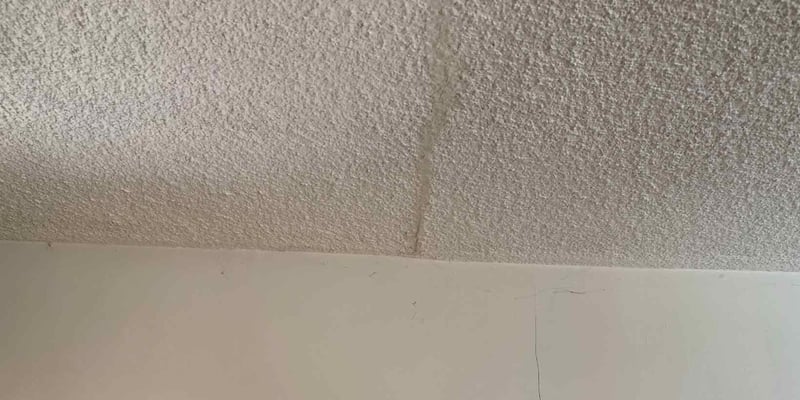Ceiling cracks are grotesque – there’s no getting around it. They’re not some avant-garde architectural statement and can’t be passed off as “character.” Ceiling cracks are a problem, but not the main problem because ceiling cracks are always indicative of a deeper issue. So, before you patch-&-paint, you’ll want to identify the culprit.
Foundation heave and foundation settlement probably aren’t the first suspects that pop into mind when it comes to ceiling cracks. However, foundation issues are a primary reason for ceiling cracks and fissures.
We have over 100 years of combined foundation repair experience here at Dalinghaus Construction. We are here to educate you on all things foundation repair…and then some.
In this article, you will learn that it’s important to determine the source of the cracks and address it before moving on to patching them up. You will also learn the steps for patching your cracked ceiling.
*Note – we saved how to patch your cracked ceiling for last because unless the root of the problem is dealt with, the cracks will return (especially if it’s due to foundation structural damage).
So, let’s dive right in.

Determine the Source of the Ceiling Cracks
It is imperative to determine the source of the cracks. Once the source has been identified, then the appropriate measures can be taken to address the primary issue. This will help mediate further ceiling cracks and fissures.
Ceiling cracks are caused by a wide variety of factors:
- Leaks & water damage – busted pipes, poor roofs, and/or improperly sealed chimneys can all result in water damage. This is usually identifiable via wet spots or discolored drywall. Address the water source first, then repair the drywall.
- High humidity – Drywall is essentially very thick paper. Damp paper loses its structural integrity quickly and it’s the same principle with drywall. This allows the drywall to pull away and separate. This is typically seen in unoccupied homes that have been open to the elements for some time. Dehumidifiers are available to help dry out your home quickly.
- Poor drywall tape jobs – Poor tape jobs can peel and leave an ugly line running across your ceiling. The crack can be easily retaped and repainted to match the rest of your ceiling.
- Foundation issues – foundation settlement and foundation heave can exert undue stress on your foundation and home’s wood framing, resulting in serious ceiling cracks. This is the hardest to repair because you can’t do it yourself.
For most of the causes above, you can find DIY repair tutorials on the web. Foundation repair, unfortunately, is not a do-it-yourself option, for the same reason there are no DIY root canals – it’s specialized and often requires permits.
Address Foundation Settlement and Foundation Heave
It is absolutely critical to address foundation settlement and foundation heave prior to fixing ceiling cracks. To do otherwise is to waste your money and your time. We’ve heard many horror stories of homeowners patch-&-painting ceiling cracks for year after year to no avail. The cracks return and bring more with them.
Why?
Because the root of the problem has not been addressed: settlement and/or heave.
Foundation settlement is when a foundation sinks into incompetent, non-loadbearing soil (also referred to as expansive soil, typically clay or loam soil). Foundation heave is when a foundation is pushed upward by expansive soil, generally when the water table is high.
In our experience, there’s generally a 90:10 split between settling and heave. Settling is far more common.
Both foundation settlement and foundation heave can wreak havoc on your foundation. Your home’s foundation was designed to remain flat, remain level, and sustain your home’s load. Settlement and heave throw your foundation off-balance, literally.
This can result in sloped floors, out of square window/door frames, cracked walls, and cracked ceilings. Unfortunately, patch-&-painting drywall cracks doesn’t return your home’s foundation back to level. Your foundation will continue to sink or bubble upward, remaining off-kilter no matter how much putty you use.
The best ways currently available on the market to return your home back to level are push pier foundation repair, helical pier foundation repair, and polyurethane deep injection.
Both push pier and helical pier systems act as underground stilt systems, the piers grounded into bedrock or competent, load-bearing soil to keep your home secure.
Polyurethane deep injection is a foam that is pumped beneath your foundation. This foam expands and solidifies, densifying the weak soil directly underneath your foundation.
Often, polyurethane is used in conjunction with steel pier systems, so foundation repair customers receive the best of both worlds.
Push piers and helical piers allow for the home to be lifted back to maximum practical recovery (the optimal amount of lift). In the foundation repair world, there is no such thing as “full recovery” or returning the home to its exact previous position.
However, once the home has been secured and returned to level, you probably won’t be able to tell the home was not quite as high as it once was. In addition, this is when you can finally patch-&-paint your ceiling cracks.
It’s important to wait to address the ceiling cracks because if they’ve been patched previously, the mud, caulk, or whatever filler you used is pushed back out during the lift. This is because the natural fissure created by the settlement is being closed once again. Thus, the filler material is displaced.
Steps to Fixing a Ceiling Crack
After the root cause of the cracks has been addressed, you can always hire a handyman to come in and fix your ceiling cracks, depending on your schedule and budget. However, if you’d like to fix it yourself, here are the steps.
Note – if your ceiling is high enough to require a ladder, ask a friend to hold the ladder steady for you as you work.
Before we dive in, here is a brief list of material you might need:
- Plaster
- A putty knife
- Paint
- A screw gun
- A drop cloth
- Drywall tape
Prep step –
Put down a drop cloth underneath the affected area so the drywall chalk, putty, or paint won’t drip onto your floor and ruin your carpet, hardwood, tile, or linoleum.
Step 1 –
Sink drywall screws into the attic blocks immediately around the crack or as close to the crack as possible. The goal is to attach the drywall to the wood support blocks behind your ceiling. This provides support and will keep the drywall securely in place, minimizing potential movement or give.
Step 2 –
Clean out and/or slightly widen the crack with a scraper of your choice. This creates a clean surface for the drywall tape and putty to adhere to.
Step 3 –
Apply a layer of drywall across the crack, followed by the putty, mud, or compound of your choice. The filler is generally applied with a putty knife. Be sure to apply enough pressure to ensure the filler seeps through the mesh drywall tape in order to fill the crack.
Step 4 –
Take a damp sponge and smooth out the putty/tape so it’s flush with the rest of your ceiling.
Step 5 –
Allow the putty to dry and then sand down any rough spots not smoothed out by the sponge.
Step 6 –
Once the treated area is smooth, you can paint over the crack with your choice of paint.
Enjoy a Crack Free Ceiling
In this article, you learned about the primary causes of ceiling cracks: leaks, water damage, high humidity, bad drywall tape jobs, and foundation issues.
You also learned that foundation repair is not a DIY and of the primary forms of foundation repair: push pier, helical pier, and polyurethane. Finally, we covered six basic steps to patching your ceiling cracks yourself.
Not sure what exactly is causing your ceiling cracks? Book a free foundation inspection to have a foundation repair expert examine your property and determine whether your cracks are from foundation issues or something else. We’ve repaired thousands of foundations across Southern California and Arizona – we can help you pinpoint your problem.
To learn what to expect during one of these foundation repair inspections, read our article How Long Does a Foundation Inspection Take & What Can Add Time.
If you haven’t had a foundation inspection yet, click our link below for a FREE inspection in our operating areas of SoCal and Arizona –







